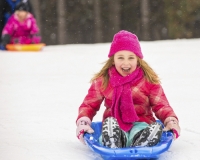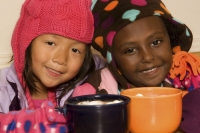2/9/16 news article
keep the snow days fun and safe

Winter has been pretty mild this year so the opportunity for kids to pull out the sleds has been slim. But with today’s snowfall and many schools calling off classes, it may be the perfect opportunity for some outdoor fun. Before sending kids out into the snow, there are a few tips that parents and caregivers need to keep in mind.
sledding safely
“Many children are into extreme sledding. Extreme sledding can cause several different types of injuries, especially to the head,” says Lisa Schwing, RN, trauma program manager at Dayton Children’s.
Thrill-seeking kids love to go down the hill head first, but this means head will be the first thing to hit any object in their path. According to Schwing, children never should sled headfirst. Instead, they should sit or kneel. Helmets are strongly recommended for children younger than 12 years old to protect their heads. In addition, don’t crowd four or five kids on one sled.
Children will use anything from a commercially made sled to cardboard boxes and garbage can lids. When buying a sled, parents should put safety first. Consider the age of the child - for example, a 12 year old should not be on a sled for an 8 year old. Steering mechanisms also are important for control while sledding.
According to the National Safety Council, more than 30,000 children are treated for sledding and tobogganing accidents each year, with most accidents involving head-related injuries.
When children race out the door to sled down their favorite hill, Schwing recommends these tips to keep them safe on the slopes:
- Never sled alone.
- Choose hills with gentle slopes that have a long run off area at the end.
- Avoid hills that end at roads, railways, rivers, fences or parking lots.
- Do not sled around frozen lakes or ponds.
- Children younger than 12 years old always should have adult supervision.
- Only sled in daylight or well-lit areas.
- Choose hills that are free from trees, rocks, holes, fences and signs and avoid hills that have icy spots and grassy or dirt areas exposed.
more than just a sled
Winter slope activities have moved from the traditional sled to snowboards and short skis. Unlike a sled, equipment like snowboards and skis take additional time to learn proper maneuver and control skills to be safe. “Don’t just jump on a snowboard and think you are a pro,” Schwing says. “Doing that can lead to serious injuries.”
warm and dry

Wet and cold is a recipe for frostbite or hypothermia. So when it comes to dressing for a day of sledding, children should layer, with hats, gloves and scarves. Two pairs of socks would be a great idea and make sure that coat is not only on, but zipped. Waterproof boots are a must, and if a child will be in the snow a lot, then water resistant pants, coats and gloves are necessary to stay safe.
Frostbite is characterized by numb fingers, ears and noses and eventually can lead to redness and pain. Hypothermia is a decrease in body temperature, which can affect brain and muscle functions and eventually lead to death.
Make sure to check on children playing in the snow frequently. Bring them in every 20 minutes or so to warm up and have a hot drink or snack.
For more information, contact:
Stacy Porter
Communications specialist
Phone: 937-641-3666
newsroom@childrensdayton.org

